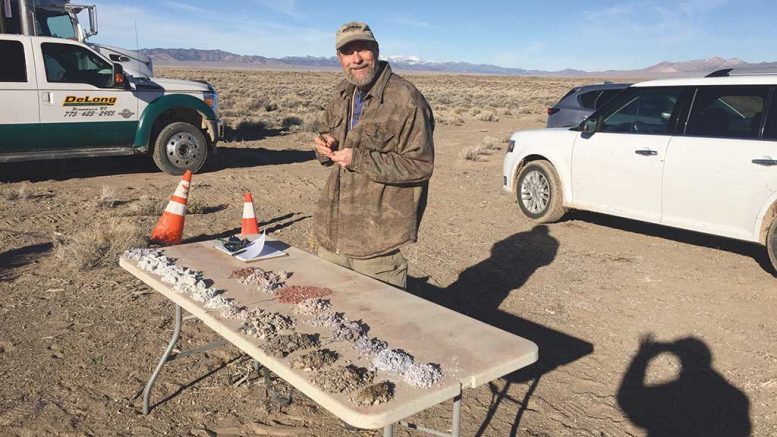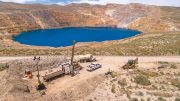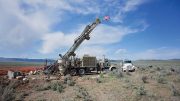James Hesketh had his eye on Midway Gold’s Tonopah project — 30 km southeast of the Round Mountain mine in Nevada’s Walker Lane trend — since 2007.
So when Midway Gold went bankrupt a decade later, Hesketh struck a deal to buy the project for US$25,000 in cash, another US$130,000 in fees to replace a bond, and a promise to pay a US$350,000 debt that Midway owed to the royalty holders on the property.
He then turned around, negotiated to cut the debt he owed to US$75,000, and offered them 1.5 million shares in his capital pool company. Most importantly, however, he slashed the 7% net smelter return royalty (NSR) on the project down to a more manageable 2% NSR, adding a clause that he could repurchase 1% of the NSR for US$1 million.

Driller and griller Daniel Nidto at Viva Gold’s Tonopah gold property in Nevada. Credit: Viva Gold.
“It wasn’t a royalty we could work with,” recalls Hesketh, who subsequently founded Viva Gold (TSXV: VAU; US-OTC: VAUCF) to develop the asset.
It was the royalty, Hesketh says, that had driven Midway Gold to consider — in his view — less-than-optimal ways of advancing the project.
“Because of the very high royalty, they were looking at it solely as a small, high-grade underground project, but the issue with that is about 80% of the resources are within 100 to 150 metres of surface,” he says.
Viva Gold took Midway Gold’s National Instrument 43-101 compliant resource on the project, based on 300 drill holes, and dropped the cut-off grade of 3 grams gold per tonne down to 0.25 gram gold per tonne.
“Most people don’t realize it, but royalties have to be included in cut-off grade calculations,” Hesketh says. “By dropping the royalty, we could lower the cut-off grade and look at what the deposit was telling us it should be, rather than what the previous owners had wanted it to be.”
Now Tonopah’s pit-constrained resource tallies 186,000 oz. gold in the measured and indicated category contained within 6,700 tonnes grading 0.95 gram gold per tonne, and another 238,000 oz. in 9,600 inferred tonnes grading 0.77 gram gold.
In December, Viva Gold started a 1,500-metre, reverse-circulation (RC) drill program over 12 holes that will focus on infilling between known mineralized structural zones and testing extensions. Partial results released at the end of January include 46 metres grading 2.2 grams gold from 143 metres’ depth, and 5 metres of 6.05 grams gold from 108 metres downhole.
Highlights from its 2018 drill program include 138 grams gold over 2 metres starting 64 metres downhole; 19.2 grams gold over 2 metres from 90 metres downhole; 12.90 grams gold over 1.5 metres from 90 metres downhole; and 14.9 grams over 2 metres from 99 metres downhole.
In addition to more drilling this year, Viva Gold is starting a program of 20 bottle-roll metallurgical tests using samples collected from its 2018 drill program.
Hesketh describes Tonopah as a “good business proposition” that offers a “really nice opportunity.”
“It has a very strong, high-grade core, which is always good when you’re designing and building a mine, and the core, in this case, is readily accessible. It’s close to surface and will be the first material mined, so it’s a mine that you can rapidly pay back.”
So far, two shallow, high-grade zones (Discovery and Dauntless) have been found a couple of hundred metres apart from each other, down to 200 metres.
“There is substantial lateral expansion capability, so we may as well drill shallow and expand the resource laterally,” he says.
Hesketh has degrees in mining engineering and mineral economics from the Colorado School of Mines, and has worked for a number of mining companies, including Cypress Amax and Canyon Resources Corp., which merged with Atna Resources.
While Hesketh is convinced Tonopah’s economics will be good, he also recognizes the challenges, given that the bedrock is covered by gravel, with only one outcrop on the property.
Kennecott found the deposit in 1993 with the help of geophysics, and its discovery hole returned an 8-metre intercept of 13 grams gold.
The property has also seen work from Newmont Mining (NYSE: NEM), which optioned the project from Midway Gold between 2002 and 2004.
“We have extensive geophysics, extensive surface and sampling, and we’ve got a number of areas where there’s a lot of broad-spaced, recon drilling over large areas, and some of that was successful and some of it wasn’t. But there are definitely holes out there that need to be followed up.”
Longer term, he says, Viva Gold will review the overall “data packet” and develop more targets in and around its property, based largely on the data that came with the acquisition.
The operations plan allows for disturbance of up to 75 acres, and so far Viva has only drilled 9 acres.
“It has got a great geometry, and the high grade is where you want it,” he says. “It will be right in front of us.”
Over the last year the junior has traded within a range of 21¢ to 50¢ per share, and at press time shares were changing hands at 32¢ apiece.
The company has 21 million shares outstanding for a $6.7-million market capitalization.
Management owns 13% of the company’s shares.
The project is situated on the northeastern side of the San Antonio Mountains, 32 km northeast of the town of Tonopah in Nye County.






Be the first to comment on "Viva breathes new life into Tonopah in Nevada"